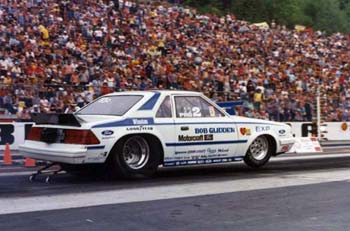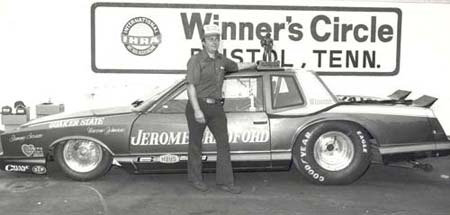BRISTOL HELPED SHAPE TODAY’S NHRA PRO STOCK
Fri, 2010-06-18 16:40
 Bristol [TN] will likely never get its props when it comes to the advancement of the Pro Stock division. As much of an influence as Detroit had in the formation of the factory hot rod category, it was Bristol which took the class to the level it now enjoys.
Bristol [TN] will likely never get its props when it comes to the advancement of the Pro Stock division. As much of an influence as Detroit had in the formation of the factory hot rod category, it was Bristol which took the class to the level it now enjoys.To the right of the creek which runs through the property which is home to both the NASCAR track and the NHRA track used to stand a building where a sanctioning body executive at his wits end suggested to his boss, maybe their series ought to step outside of the conventional rules the Pro Stock division had used since its introduction. At the time, the rules package was cumbersome and considered anything but fair.
Ted Jones was the executive who suggested to the IHRA’s founder, Larry Carrier, they scrap the traditional method of factoring the different manufacturing combinations and adopt their own special breed of Pro Stock classification.
Thus was born the mountain motor Pro Stocker.

Warren Johnson raced many years with the IHRA in their mountain motor division. The concept of racing mountain motors in Pro Stock on a national event level originated in Bristol, Tenn.
To the right of the creek which runs through the property which is home to both the NASCAR track and the NHRA track used to stand a building where a sanctioning body executive at his wits end suggested to his boss, maybe their series ought to step outside of the conventional rules the Pro Stock division had used since its introduction. At the time, the rules package was cumbersome and considered anything but fair.
Ted Jones was the executive who suggested to the IHRA’s founder, Larry Carrier, they scrap the traditional method of factoring the different manufacturing combinations and adopt their own special breed of Pro Stock classification.
Thus was born the mountain motor Pro Stocker.
“It was a nightmare without end because you always had to adjust the rules,” said Jones, of the factoring systems for the first few years of the Pro Stock classification. “You had several weight breaks and they were for every combination under the sun. You had them for staggered valves, cylinder heads, wheelbase, and so on and so forth.
“Most every Pro Stocker had to run a small block because if you didn’t, you’d have to run so much weight that it was unreasonable and the parts breakage for running such a heavy combination was unreal. It was a real headache.”
Jones went to watch an outlaw race in 1976 featuring cars running upwards of an unheard of for that era – 500 cubic inches. Inspired by the show he witnessed, he returned to Bristol with enough inspiration to walk into Carrier’s office with a bold proposal.
“I was tired of the never-ending nightmare,” Jones said. “I had watched Bob Glidden get the Ford Cleveland combination hammered so much that he was the only one competitive with that combination. I walked into Larry’s office and asked if he wanted to make our Pro Stock cars scream and have the class become a conversation piece. I knew he was interested in what I was saying and I couldn’t help it. The presentation began flowing.
“I told him that we needed to come out with a new version of Pro Stock and call it run 'whatcha brung'. No cubic inch limits … bolt in the biggest damn motor you can and bring it on. There will be safety of course. But make them weigh 2,350 pounds, run pump gas and have two four barrel carburetors. We don’t even need to know how big the motors are. We’ll just tell them to put the big motors in there and come on out and race.”
The publicity followed the IHRA’s new style of Pro Stock racing. Coming during an era when the Pro Stockers were the only professional doorslammer division in major championship drag racing, it didn't take long for the news to be spread across the pages of the leading drag racing magazines, namely Super Stock & Drag Illustrated, journalist proclaimed the excitement of the fast doorslammers.
And then Rickie Smith broke a major barrier; he put one of the Pro Stockers into the seven second zone in 1980. A year later the talk was about the IHRA and how their seven second runners were showcasing the skills of the veterans Warren Johnson, Ronnie Sox, Roy Hill and a score of other lesser known drivers.
It became apparent, in a day and age when the IHRA was considered a legit threat to the NHRA, the IHRA’s 7.9 second runners were upstaging the NHRA’s 8.3-second superstars.
The NHRA at the end of the 1981 opted to abandon their traditional rules package for a 500-inch engine limit with a 2350 pound universal package. While the engines are considered small in today’s mountain motor era, at the time they were almost 200 cubic inches larger than anything the average competitor had run in the arena.
Warren Johnson raced many of those IHRA mountain motor races in the late 1970s and early 1980s, scoring consecutive championships in 1979 and 1980. Running the larger displacement engines wasn’t much of a challenge for him as he’d largely raced big block combinations in the pounds per cubic inch format divisions.
The IHRA mountain motor Pro Stock format, developed in the mountains of Bristol, provided the perfect opportunity for Johnson. He’s upfront in pointing out the time in the mountain motor Pro Stock division enabled him to learn how to win. He used the experience to become a player in the NHRA's 500-inch Pro Stock ranks.
“I have to give the IHRA credit for allowing me to learn how to race,” said Johnson, who is now the winningest Pro Stock racer in NHRA competition. “It was a great learning experience for me to springboard to this.”
Today’s Pro Stock has developed into high tech, big business and although the building which hosted the decision-making process to go to larger displacement engines has been razed, the IHRA no longer fields Pro Stock, Still, those who know their drag racing history knows the role Bristol played in developing the exciting division.
Categories:





































